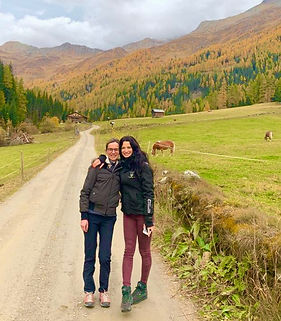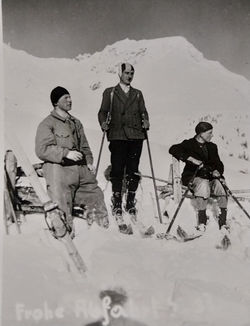Chi siamo
Johanna Trojer è la proprietaria del maso. È cresciuta in un maso di montagna a San Candido, in Alto Adige, dove lavora anche. Ama la natura e la sua bellezza incontaminata. La ristrutturazione del maso nel 2020 è stata entusiasmante e molto intensa, e ora lei e sua figlia Stephanie non vedono l'ora di dare nuova vita a questo antico maso insieme a voi e di ispirarvi con la semplice armonia di questo piccolo angolo di mondo. Perché la bellezza ha un effetto rilassante senza essere noiosa.

Un po di storia...
Negli anni precedenti la morte dell'ultimo pastore di Kalkstein, nella parte più remota della valle di Villgraten, Bergmann Johann, cugino di mia nonna materna, avvenuta nel 1991, egli era molto preoccupato che la sua vecchia fattoria fatiscente, che aveva urgente bisogno di essere ristrutturata, avrebbe mai trovato un successore.
 |  |  |  |  |  |
|---|
I campi sono ripidi e brulli, i boschi sono inaccessibili ai macchinari moderni, la stalla non è più adatta all'allevamento rispettoso degli animali e la strada che porta su è stretta e tortuosa. Raccontò a mia madre Irma che aveva cinque figli (anche noi siamo cresciuti in un maso di montagna dietro l'angolo a San Candido, in Alto Adige), e che uno di loro sarebbe probabilmente interessato a prendersene cura e continuare a lavorarlo. Per lui era molto importante che nessuno vendesse il maso, perché diceva che c'erano abbastanza parenti lontani interessati, ma solo per venderlo.
Mia madre gli promise di non vendere, e lui le cedette la piccola casa nella speranza che il suo desiderio si avverasse. Noi (i miei fratelli e mia madre) tornammo qui ogni estate negli anni successivi per falciare i campi, raccogliere il fieno e, naturalmente, mangiare gnocchi in soggiorno a pranzo e, dopo il lavoro, fare "marenden" (= spuntino). Nel 2008, sono arrivata qui e ho vissuto in questa casa per otto estati e quattro inverni con mia figlia Stephanie, quando non frequentava l'università.
Solo quattro inverni, non otto, perché, a causa del gelo costante, l'acqua fece scoppiare le vecchie tubature della stalla nel quarto inverno. Ma questo mi ha permesso di conoscere molto bene la fattoria, di analizzare in dettaglio le zone fredde e calde, i punti soleggiati e gli accumuli di neve, di individuare i punti deboli e di individuare i punti buoni, persino ottimi. A meno due gradi Celsius in camera da letto, il nostro stato era quasi come un'esperienza di benessere, ma a meno sette gradi non ci si poteva nemmeno girare nel letto a causa dei cuscini ghiacciati.
Col tempo, mi sono affezionato alla casa e alla fattoria e l'ho fatto capire chiaramente a mia madre. Per lei, questa fattoria era tutto, e il suo più grande desiderio era darle nuova vita, cosa che ero determinato a fare, così come non avevo intenzione di venderla. Di conseguenza, nel 2011 mi ha consegnato la fattoria e, dopo anni di tira e molla, ho iniziato la grande avventura della ristrutturazione, durata da aprile 2018 fino a poco prima della fine del 2020.
Farm's location, history and people
Our listed mountain farmhouse or country house is located on a sunny slope in the heart of the Pustertal Valley at 1,300 meters above Heinfels Castle, in the municipality of Heinfels, which has a population of approximately 1,000. The farmhouse is part of a farm complex consisting of three farms. The heavenly view from the farmhouse is always the same, but the light is different, unique, every moment.
The eastern half of the house – one floor lower in the Middle Ages – was likely the first farmhouse ever built on this slope, as confirmed by the first documented mention in 1199. The old Rachkuchl (salt kitchen) and the old bacon or granary cellar, where the bathtub now stands, as well as the green room on the upper floor, are among the first rooms built in the house. The western half of the house was added later, probably in the early 19th century. In recent centuries, up to three families have lived in this house. For this reason, there are two cellars, two kitchens, and two living rooms.
The great-great-grandfather of my great-uncle, Pastor Johann Bergmann, my great-great-great-grandfather, was also named Johann Bergmann and was born on December 28, 1736. He married Maria Roflerin from Sillianberg in 1773 and died in 1813 "of old age," as can be read in his family tree, after the death of his wife in 1805, who died of "dropsy." The surname Bergmann thus remained associated with this farm for more than 250 years.
At that time, the Mittereggerschneiderhof was called Rainerhof, after the hamlet of Rain, the name still used today for the farm complex and its surroundings on this slope. In the mid-19th century, the Sillian parish register mentions the name "zu Rain-Mittereggen" (to Rain-Mittereggen), when Pastor Bergmann's grandfather, Alois, a farmer and master tailor, married Katharina Obristhofer. Because of his profession as a tailor, this was incorporated into the farm's name, according to the archives in the year ... They had two children, one of whom died on the day of his birth (May 11, 1853). Their son, Johann Bergmann zu Peterer, Mittereggen in Hinterheimfels, the pastor's father, was born on June 2, 1859, and married Johanna Lusser, born in 1872, daughter of Anton and Maria Prugger. They had a total of five children.
In the 1960s, the road up from the valley was built. Until then, there was only a now overgrown footpath, also called the Kirchensteig (church path), since people only went down to the valley on Sundays to attend Holy Mass. (Photo: Heinfelsberg, 1960s, without a road) During the same years, the Höfl received electricity and later even a telephone connection. The outhouse remained in use until the early 2000s, as did the "Seachte" (sinkhole), still preserved in the kitchen corner of the Rachkuchl (kitchen kitchen), where the priest's then very elderly sisters washed sheets with ash until the 1990s. However, they couldn't afford a radio or television; the ORF broadcast was "too expensive," as I was told. Their iron frugality did have one major advantage, however, because the old building structure was thus preserved and can be experienced for posterity. We are very proud to have received only the best reviews on TrustYou, Google, and other sites, and will continue to strive to do our best. In 2025, we will become a member of the Farm Holidays association and are now pleased to be able to identify ourselves as a country farm, both digitally and in print.
